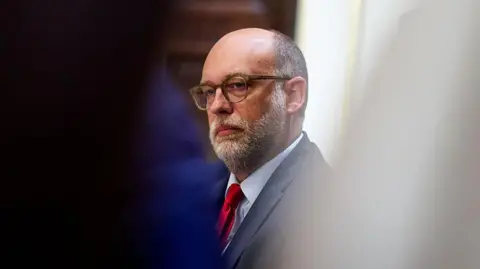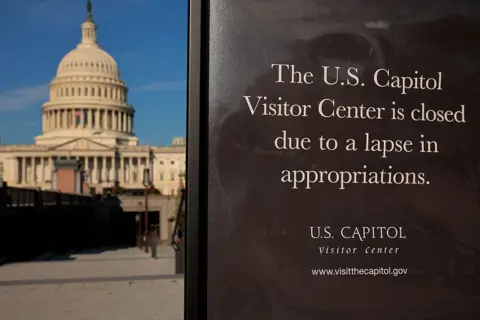Kayla Epstein And
Nardin Saad
 Getty Images
Getty ImagesThe Trump administration has begun laying off thousands of federal workers in an attempt to put pressure on Democrats amid ongoing government shutdown.
“The RIFs have begun,” White House Office of Management Director Russell Vought said in a post on X Friday morning, referring to the acronym for “force reduction.”
A spokesman for his office confirmed the cuts had begun and were “significant.” Their size and scope began to come into focus later Friday, when the administration said seven agencies had begun laying off more than 4,000 employees.
President Donald Trump has repeatedly threatened to use the shutdown to achieve his longtime goal of shrinking the federal workforce.
By law, the federal government must give its employees at least 30 days' notice of its termination.
Following Vought's tweet, major departments such as Treasury and Health and Human Services (HHS) confirmed they were sending notices to employees, and the Department of Homeland Security, where many of its employees are considered essential, said it would furlough employees at its Cybersecurity and Infrastructure Security Agency.
But precise details were scarce.
Two of the largest unions, the American Federation of Government Employees and the AFL-CIO, filed a lawsuit challenging the legality of Vought's announced plans to implement layoffs during the shutdown.
On Friday, when he said the process had begun, they asked a Northern California federal court to temporarily block the move.
“It is disgraceful that the Trump Administration used the government shutdown as an excuse to illegally lay off thousands of workers who provide critical services to communities across the country,” said AFGE President Everett Kelly.
In arguing against the temporary restraining order, OMB lawyers revealed which agencies and how many of their employees would be affected first, indicating that approximately 4,600 employees will receive RIF notices starting Friday.
“The President, through OMB, has determined that the agencies must operate more efficiently and has directed them to consider steps to optimize their workforces in light of ongoing appropriation cuts,” Justice Department attorneys argue in the lawsuit.
More than a quarter of the cuts will be made at the Treasury Department, where notices have been sent to about 1,446 employees.
HHS notified between 1,100 and 1,200 employees, the statement said.
The Departments of Education and the Departments of Housing and Urban Development intended to lay off at least 400 employees, while the Departments of Commerce, Energy, Housing and Urban Development and Homeland Security planned to cut between 176 and 315 employees, according to the documents.
There was no indication of how many notices the agencies issued Friday.
The document also said that on Friday, 20 to 30 EPA employees received a “RIF intent” notice, notifying them that they may be affected in the future. Other federal agencies may also make cuts.
Government lawyers said the unions failed to prove that their members would suffer irreparable harm as a result of the layoffs, which is necessary for a judge to issue a restraining order. But they said a restraining order would “irreparably harm the government.”
A temporary restraining order would prevent agencies from “determining how best to organize their workforce,” they argued, noting that the government has traditionally been given the broadest latitude to “manage its internal affairs.”
 Getty Images
Getty ImagesThe layoffs are unprecedented. During past shutdowns, furloughed employees returned to work when the government reopened and were retroactively paid for the time they were away.
Both furloughed and “essential” workers who still have to perform their job duties are not paid when government funding is temporarily suspended.
current shutdown began 10 days ago after lawmakers failed to reach an agreement on funding measures to keep the government open.
“They held off for 10 days,” Republican Sen. John Thune told reporters, referring to the White House. “At some point, they're going to have to make some of these decisions and prioritize where they're going to spend money when the government is shut down.”
Senate Minority Leader Chuck Schumer, a Democrat, accused Trump and Vought of creating “intentional chaos.”
Democrats refused to vote for a Republican spending plan that would reopen the government, saying any resolution must preserve expiring tax cuts that would slash health insurance costs for millions of Americans and roll back Trump's cuts to Medicaid, a health care program for seniors and low-income people.
Republicans blame Democrats for the unnecessary government shutdown and blame them for the spillovers caused by the federal government shutdown.
The shutdown meant that “non-essential” federal workers were furloughed. It currently affects about 40% of the federal workforce—about 750,000 people.
By law, furloughed employees should receive back wages after the quarantine ends and they return to work, but the Trump administration hinted that this might not happen.
Significantly reducing the federal workforce has been a long-term priority for Vought.
The president and his budget chief hailed the shutdown as a unique opportunity to make new layoffs on top of the thousands of cuts they have made since Trump returned to office in January through a combination of layoffs, buyouts, administrative leaves and resignations.
The Public Service Partnership, a bipartisan group that studies government, estimates that the federal workforce has been cut by about 200,000 people as of Sept. 23.
Career services firm Challenger, Gray & Christmas, reported last month that the public sector announced 299,755 planned job cuts this year, of which 289,363 were federal employees affected by the White House Department of Government Effectiveness (Doge) cost-cutting efforts. originally led by billionaire Elon Musk..
Before the shutdown, Vought's office directed federal agencies to prepare retrenchment plans aimed at cutting employees or programs that might run out of funding or that “do not align with the president's priorities,” Politico reported.
A day after the shutdown began, Trump wrote on Truth Social that he had met with Vought “to determine which of the many Democratic agencies, most of which are political scams, he recommends cuts, and whether those cuts will be temporary or permanent.”









